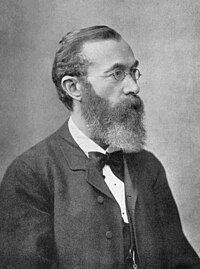Introduction to Psychology 1/IPSY101/History/Structuralism
| “ | Physiology seeks to derive the processes in our own nervous system from general physical forces, without considering whether these processes are or are not accompanied by processes of consciousness. | ” |
| —Wilhelm Wundt | ||
Wundt viewed psychology as a scientific study of conscious experience, and he believed that the goal of psychology was to identify components of consciousness and how those components combined to result in our conscious experience.
Wundt used introspection (he called it “internal perception”), a process by which someone examines their own conscious experience as objectively as possible, making the human mind like any other aspect of nature that a scientist observed. Wundt’s version of introspection used only very specific experimental conditions in which an external stimulus was designed to produce a scientifically observable (repeatable) experience of the mind (Danziger, 1980[1]). The first stringent requirement was the use of “trained” or practiced observers, who could immediately observe and report a reaction. The second requirement was the use of repeatable stimuli that always produced the same experience in the subject and allowed the subject to expect and thus be fully attentive to the inner reaction. For example, highly trained assistants would be given a stimulus such as a ticking metronome and would reflect on the experience. They would report what the stimulus made them think and feel (McLeod, 2008[2]). The same stimulus, physical surroundings and instructions were given to each person. These experimental requirements were put in place to eliminate “interpretation” in the reporting of internal experiences and to counter the argument that there is no way to know that an individual is observing their mind or consciousness accurately, since it cannot be seen by any other person. This attempt to understand the structure or characteristics of the mind was known as structuralism.
Wundt established his psychology laboratory at the University at Leipzig in 1879. In this laboratory, Wundt and his students conducted experiments on, for example, reaction times. A subject, sometimes in a room isolated from the scientist, would receive a stimulus such as a light, image, or sound. The subject’s reaction to the stimulus would be to push a button, and an apparatus would record the time to reaction. Wundt could measure reaction time to one-thousandth of a second (Nicolas & Ferrand, 1999)[3].
References
- ↑ Danziger, K. (1980). The history of introspection reconsidered. Journal of the History of the Behavioral Sciences, 16, 241–262.
- ↑ McLeod, S. (2008). Wilhelm Wundt. Retrieved from https://www.simplypsychology.org/wundt.html
- ↑ Nicolas, S., & Ferrand, L. (1999). Wundt’s laboratory at Leipzig in 1891. History of Psychology, 2, 194–203.
- Source
- This page was proudly adapted from Psychology published by OpenStax CNX. Oct 31, 2016 under a Creative Commons Attribution 4.0 license. Download for free at http://cnx.org/contents/4abf04bf-93a0-45c3-9cbc-2cefd46e68cc@5.52.
